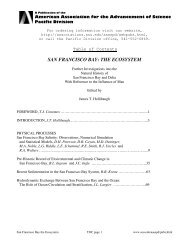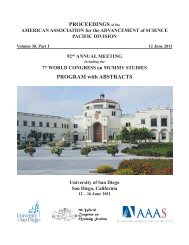Vol 31, Part I - forums.sou.edu ⢠Index page - Southern Oregon ...
Vol 31, Part I - forums.sou.edu ⢠Index page - Southern Oregon ...
Vol 31, Part I - forums.sou.edu ⢠Index page - Southern Oregon ...
Create successful ePaper yourself
Turn your PDF publications into a flip-book with our unique Google optimized e-Paper software.
ABSTRACTS – Symposia<br />
Climate change and land use could trigger extensive and<br />
possibly abrupt shifts in vegetation, wildfire regimes, and<br />
fire-related erosion. Our ability to anticipate such changes<br />
depends on our understanding of these past relationships.<br />
However, detailed records of vegetation, fire and geomorphic<br />
regimes are rarely all available at sensitive sites, for<br />
example along the edges of species distributions. At City<br />
of Rocks National Reserve (CIRO), <strong>sou</strong>th-central Idaho,<br />
we used fossil woodrat middens to reconstruct local vegetation<br />
and alluvial charcoal stratigraphy to evaluate fire and<br />
fire-related geomorphic responses at the migrating front of<br />
single-needle pinyon (Pinus monophylla) and Utah juniper<br />
(Juniperus osteosperma), the dominant trees in the Great<br />
Basin. Frequent fires burned in the periods 10,700-9500 cal<br />
yr BP and 7200-6700 cal yr BP. Fire-free conditions characterized<br />
the intervals 9500-7200 and 6700-4700 cal yr BP.<br />
Episodic debris flows were deposited during early and late<br />
Holocene wetter climate, when vegetation was denser. Frequent<br />
sheetfloods were deposited during mid-Holocene drier<br />
climate. Utah juniper colonized CIRO at ~3800 cal yr BP.<br />
Frequent fires were recorded 2400-2000, 850-700 and 550-<br />
400 cal yr BP. Although single-needle pinyon colonized by<br />
2800 cal yr BP, it did not expand broadly across CIRO until<br />
after 700 yr BP. Replication of our methodologies at other<br />
sites in the region may confirm associations and causal relationships<br />
between Holocene changes in vegetation, fire, and<br />
sedimentation.<br />
41 At home on the Range: Loss of Sagebrush May Open<br />
New Habitat for Harvester Ants, and Imperil a Threatened<br />
Mustard Endemic to Southwest Idaho, IAN ROBERTSON<br />
(Department of Biological Sciences, Boise State University,<br />
1910 University Drive, Boise, ID 83725; iroberts@boisestate.<strong>edu</strong>).<br />
Throughout the Great Basin, disturbance events such as<br />
wildfire are causing sagebrush stands to be replaced by open<br />
grassland. In <strong>sou</strong>thwestern Idaho, the shift from sagebrush to<br />
grassland may allow Owyhee harvester ants, Pogonomyrmex<br />
salinus, to colonize areas that historically were unsuitable<br />
for nesting. Because harvester ants are generalist granivores,<br />
large influxes of ants could have a profound effect on plant<br />
communities, with the rarest species being most vulnerable.<br />
We have been studying the dynamics of harvester ant colonization<br />
in areas occupied by slickspot peppergrass, Lepidium<br />
papilliferum, a rare mustard endemic to <strong>sou</strong>thwest Idaho.<br />
Several years of monitoring suggest that Owyhee harvester<br />
ant numbers are on the rise. For example, between 2010<br />
and 2011 the number of ant colonies recorded at 15 populations<br />
of L. papilliferum increased by 7.6% (from 841 to<br />
905 colonies over 85.3 ha surveyed). At one location there<br />
has been a 64% increase in harvester ant colonies over the<br />
past three years (from 53 to 87 colonies over a 5.1 ha area).<br />
The abundance of harvester ant colonies is negatively associated<br />
with sagebrush cover and positively associated with<br />
the availability of non-Bromus grasses. Foraging studies<br />
have shown that P. salinus prefer the seeds of Poa secunda<br />
(Sandberg bluegrass) and various mustards over the seeds of<br />
Bromus tectorum (cheatgrass). Slickspot peppergrass seeds<br />
are among those readily consumed by P. salinus. Thus, the<br />
expansion of harvester ant colonies into L. papilliferum habitat<br />
represents a serious threat to the survival and long-term<br />
viability of this threatened mustard.<br />
42 Insect Responses to Intra- and Interannual Variations<br />
in Weather: Implications for Climate Change in Sagebrush<br />
Steppe, ASHLEY ROHDE 1,2 *, DAVID PILLIOD 1 , and<br />
STEPHEN NOVAK 2 ( 1 U.S. Geological Survey, Forest and<br />
Rangeland Ecosystem Science Center, 970 Lusk St. Boise,<br />
ID 83706; 2 Department of Biology, Boise State University,<br />
Boise, ID 83725; arohde@usgs.gov; dpilliod@usgs.gov;<br />
snovak@boisestate.<strong>edu</strong>).<br />
Climate has shaped the distribution of plants and animals<br />
throughout biological evolution and the recent accelerated<br />
climate change caused by human activities is no exception.<br />
Species distributions are expected to shift as local and<br />
regional climates change, but this process may be inhibited<br />
by modern landscapes that are fragmented by human infrastructure<br />
and land use. R<strong>edu</strong>ctions in biodiversity due to<br />
climate change are predicted to be most severe in grassland<br />
ecosystems, such as sagebrush steppe. These systems are<br />
particularly susceptible to climate change because of their<br />
aridity, high level of conversion, and low level of protection<br />
relative to other major habitat types. The goal of this study<br />
is to document the climatic conditions associated with distinct<br />
insect communities and determine how land management<br />
actions may influence these relationships. We identified<br />
>50,000 insects to family using pitfall and flight traps<br />
placed in arrays within the Bureau of Land Management<br />
Jarbidge Field Office in <strong>sou</strong>thwestern Idaho. Sampling was<br />
conducted from 2009-11. We examined the relative influence<br />
of weather and habitat conditions to determine the most<br />
important factors influencing insect community composition.<br />
Preliminary results from this study show that intra- and<br />
inter-annual weather patterns, particularly temperature, have<br />
a strong effect on insect community composition.<br />
Computability and Complexity<br />
in Mathematics<br />
Tuesday, 9:00 a.m. in PONDEROSA PINES 1 and 2<br />
43 Elliptic Curves: From Diophantus to Modern Cryptography,<br />
LAWRENCE C WASHINGTON (Department of<br />
Mathematics, University of Maryland, College Park, MD<br />
20742; lcw@umd.<strong>edu</strong>).<br />
What do the motion of a pendulum, the possible areas<br />
of right triangles with rational sides, and identity based cryptography<br />
have in common They all involve elliptic curves.<br />
59








